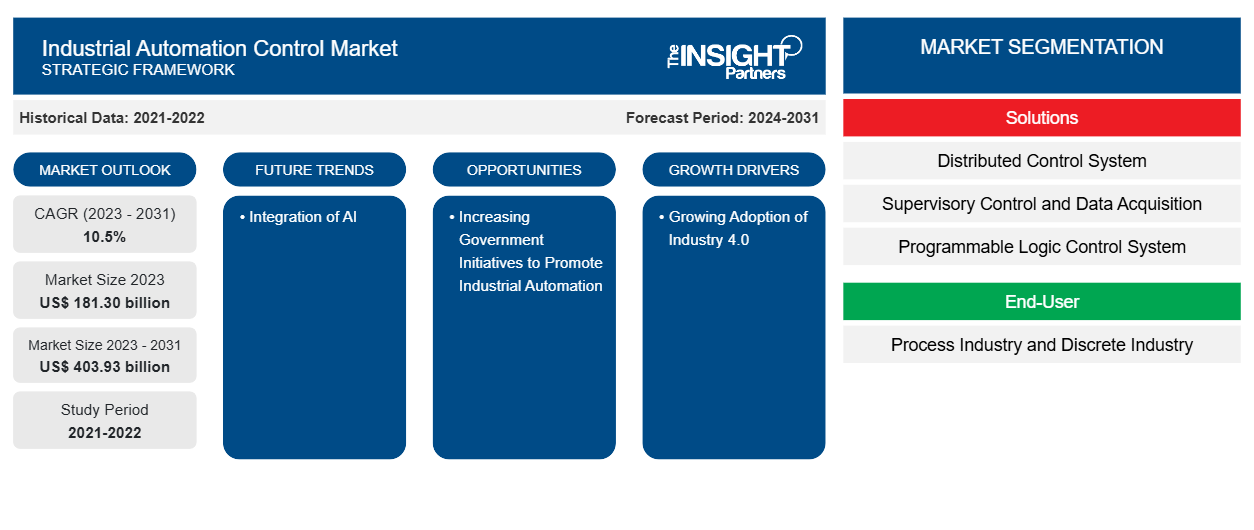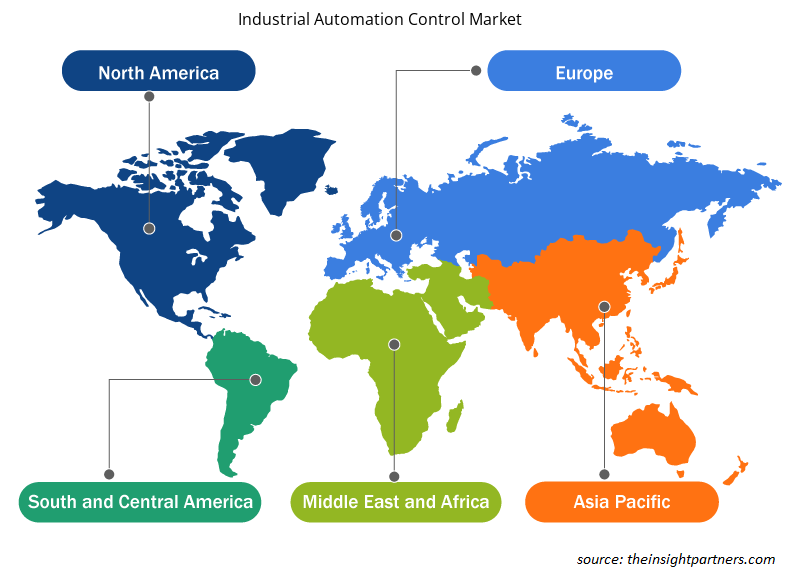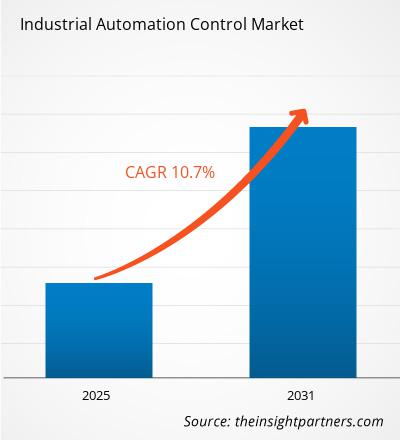Se espera que el tamaño del mercado de control de automatización industrial alcance los 391.630 millones de dólares estadounidenses para 2031, frente a los 193.220 millones de dólares estadounidenses de 2024. Se prevé que el mercado registre una tasa de crecimiento anual compuesta (TCAC) del 10,7 % entre 2025 y 2031. Es probable que la integración de la inteligencia artificial (IA) y el aprendizaje automático (AA) impulse nuevas tendencias en el mercado en los próximos años.
Análisis del mercado de control de automatización industrial
La automatización en la fabricación abarca una amplia gama de aplicaciones, desde el control de líneas de montaje y procesos de envasado hasta la supervisión de tareas complejas como el mecanizado de precisión o la producción química. Gracias a la recopilación y el análisis de datos en tiempo real, los sistemas automatizados pueden detectar fallos, predecir las necesidades de mantenimiento y optimizar los flujos de trabajo, lo que se traduce en una reducción de averías y tiempos de inactividad. Esto se traduce en un entorno de producción más ágil, capaz de responder con rapidez a los cambios del mercado o a la demanda de los consumidores. Al reducir los errores humanos y optimizar la supervisión operativa, el control de la automatización industrial también desempeña un papel fundamental en la mejora de la seguridad en el trabajo. Para las empresas, puede suponer un ahorro significativo de costes, ciclos de producción más rápidos y la capacidad de escalar las operaciones con mayor eficacia. A medida que las industrias continúan adoptando las tecnologías de automatización, pueden alcanzar mayores niveles de competitividad e innovación, posicionándose para el crecimiento y el éxito a largo plazo en un mercado cada vez más digital y globalizado.
Descripción general del mercado de control de automatización industrial
El control de automatización industrial se refiere al uso de tecnologías y sistemas de control avanzados, como computadoras, robots y sistemas de información, para gestionar y supervisar procesos y maquinaria industrial. El objetivo del control de automatización industrial es mejorar la eficiencia, la productividad y la seguridad reduciendo la intervención humana en las operaciones de fabricación. En el ámbito empresarial, el control de automatización industrial optimiza la producción al automatizar tareas repetitivas y laboriosas, lo que permite obtener resultados más rápidos, precisos y consistentes. Mediante la automatización, las empresas pueden mejorar la eficiencia operativa, reducir el riesgo de errores y minimizar los costes laborales, manteniendo al mismo tiempo una alta calidad del producto. Estos sistemas suelen integrar sensores, robótica e inteligencia artificial (IA) para supervisar y controlar las líneas de producción en tiempo real, realizando ajustes para mejorar el rendimiento y reducir el desperdicio.
Personalice este informe según sus necesidades
Recibirá personalización de cualquier informe, sin cargo, incluidas partes de este informe o análisis a nivel de país, paquete de datos de Excel, así como también grandes ofertas y descuentos para empresas emergentes y universidades.
Mercado de control de automatización industrial: Perspectivas estratégicas

-
Obtenga las principales tendencias clave del mercado de este informe.Esta muestra GRATUITA incluirá análisis de datos, desde tendencias del mercado hasta estimaciones y pronósticos.
Impulsores y oportunidades del mercado del control de automatización industrial
Adopción generalizada del control de automatización industrial en diversas industrias
La penetración del control de automatización industrial está cobrando impulso en sectores distintos al automotriz. En el pasado reciente, las industrias no automotrices tenían una penetración muy limitada en comparación con la automotriz. Con la creciente funcionalidad de equipos como los robots industriales , se prevé que las industrias no automotrices acelerarán aún más la adopción del control de automatización industrial.
Además de las industrias, la penetración también está aumentando entre los países. Los mercados desarrollados, como China, EE. UU. y Japón, presentan una mayor penetración; sin embargo, aún existen amplias oportunidades para que el mercado industrial siga creciendo, incluso en los mercados desarrollados. Por ejemplo, en 2023, China representó el 35 % de la producción bruta, casi el triple de la producción bruta de EE. UU. y se sitúa en segundo lugar con un 12 %. La perspectiva de nuevas instalaciones es notable en muchos de estos países, especialmente en la industria no automotriz. Este crecimiento se atribuye a la necesaria modernización y transformación que requieren estos mercados. Estas estadísticas son prometedoras para los fabricantes, ya que indican el amplio margen para un mayor crecimiento en la adopción.
Aumento del apoyo gubernamental
La importancia del gobierno y los legisladores en la promoción del control de la automatización industrial ha aumentado significativamente a medida que las industrias a nivel mundial se esfuerzan por mejorar la eficiencia y agilizar los procesos de fabricación. Dado que el control de la automatización industrial desempeña un papel fundamental en el impulso de la Cuarta Revolución Industrial, los gobiernos y los legisladores deben establecer los mecanismos de apoyo y los marcos regulatorios adecuados para fomentar su adopción y crecimiento generalizados. Por ejemplo, en India, el gobierno ha implementado varias medidas para fortalecer el sector de la fabricación inteligente, siendo una de las iniciativas clave el programa de Incentivos Vinculados a la Producción ( PLI ). Lanzado en 2020, el programa PLI se dirige a 14 sectores, incluidos los automóviles, los productos farmacéuticos, los textiles, el procesamiento de alimentos y los electrodomésticos, como parte de una estrategia más amplia para promover la fabricación nacional. El programa está diseñado para alentar a las empresas a adoptar prácticas de fabricación inteligente ofreciendo incentivos financieros a aquellas que producen bienes localmente y cumplen con criterios específicos de inversión, ventas y exportación. Esta iniciativa tiene como objetivo mejorar la competitividad de estas empresas y, a su vez, elevar el valor general del sector manufacturero de India.
De manera similar, en EE. UU., en 2023, el Departamento de Energía (DoE) anunció una iniciativa de 22 millones de dólares estadounidenses para apoyar 12 programas estatales con el fin de acelerar la adopción de la fabricación inteligente en pequeñas y medianas empresas. Esta iniciativa, financiada por la Ley Bipartidista de Infraestructura del Presidente, busca mejorar el acceso a las tecnologías de fabricación inteligente y la computación de alto rendimiento en el sector manufacturero estadounidense. Además, en agosto de 2023, el Instituto de Robótica Avanzada para la Fabricación (ARM) preseleccionó ocho nuevos proyectos tecnológicos de ciclo corto y planea otorgar una contribución total de aproximadamente 3,26 millones de dólares estadounidenses para su financiación a través de su Convocatoria de Proyectos Tecnológicos 23-01. Se espera que estas iniciativas ofrezcan una oportunidad significativa para impulsar el sector de la fabricación inteligente , impulsando así el crecimiento del mercado del control de la automatización industrial .
Análisis de segmentación del informe de mercado de control de automatización industrial
Los segmentos clave que contribuyeron a la derivación del análisis del mercado de control de automatización industrial son el sistema y el usuario final.
- Según el sistema, el mercado de control de automatización industrial se segmenta en SCADA, DCS, PLC, PLM y otros. El segmento SCADA dominó el mercado en 2024.
- Según el usuario final, el mercado de control de automatización industrial se divide en la industria de procesos y la industria discreta. El segmento de la industria discreta dominó el mercado en 2024.
Análisis de la cuota de mercado del control de automatización industrial por geografía
El mercado de control de automatización industrial se segmenta en cinco regiones principales: América del Norte, Europa, Asia Pacífico, Oriente Medio y África (MEA) y América del Sur. América del Norte dominó el mercado en 2024.
En toda Norteamérica, los avances tecnológicos han impulsado mercados altamente competitivos, posicionando a la región como un centro de innovación y fortaleza económica. Las empresas de la región optimizan constantemente sus procesos de negocio para satisfacer la creciente demanda de productos y servicios de alta calidad de la manera más eficiente.
Empresas globales están implementando diversas iniciativas para impulsar el crecimiento del mercado de control de automatización industrial. Por ejemplo, en diciembre de 2024, ONDEX Automation ("ONDEX" o la "Compañía") anunció la finalización de una alianza con Automation & Control Inc. ("ACI"), empresa líder en sistemas de control y servicios de automatización industrial con sede en Moorestown, Nueva Jersey. Esta alianza estratégica marca un hito importante en la misión de ONDEX Automation de ofrecer soluciones de automatización innovadoras a sus clientes del sector manufacturero norteamericano. Con el respaldo de Shore Capital Partners, una firma de capital privado con sede en Chicago, ONDEX Automation está construyendo un integrador de sistemas líder para satisfacer las necesidades de sus clientes del sector manufacturero norteamericano. ONDEX busca activamente nuevas oportunidades de colaboración con integradores de sistemas de automatización de fábricas que aporten una amplia gama de capacidades, un talento de ingeniería experimentado y un compromiso compartido con la innovación y la excelencia. Entre los actores clave del mercado de control de automatización industrial norteamericano se encuentran Rockwell Automation Inc., ABB Ltd. y Mitsubishi Electric Corporation. Estas empresas impulsan la innovación y definen el futuro de la automatización industrial en la región.
Perspectivas regionales del mercado de control de automatización industrial
Los analistas de Insight Partners han explicado detalladamente las tendencias y los factores regionales que influyen en el mercado de control de automatización industrial durante el período de pronóstico. Esta sección también analiza los segmentos y la geografía del mercado de control de automatización industrial en América del Norte, Europa, Asia Pacífico, Oriente Medio y África, y América del Sur y Central.

- Obtenga los datos regionales específicos para el mercado de control de automatización industrial
Alcance del informe de mercado de control de automatización industrial
| Atributo del informe | Detalles |
|---|---|
| Tamaño del mercado en 2024 | US$ 193.22 mil millones |
| Tamaño del mercado en 2031 | US$ 391.63 mil millones |
| CAGR global (2025-2031) | 10,7% |
| Datos históricos | 2021-2023 |
| Período de pronóstico | 2025-2031 |
| Segmentos cubiertos |
Por sistema
|
| Regiones y países cubiertos |
América del norte
|
| Líderes del mercado y perfiles de empresas clave |
|
Densidad de actores del mercado de control de automatización industrial: comprensión de su impacto en la dinámica empresarial
El mercado de control de automatización industrial está en rápido crecimiento, impulsado por la creciente demanda de los usuarios finales debido a factores como la evolución de las preferencias de los consumidores, los avances tecnológicos y una mayor comprensión de los beneficios del producto. A medida que aumenta la demanda, las empresas amplían su oferta, innovan para satisfacer las necesidades de los consumidores y aprovechan las tendencias emergentes, lo que impulsa aún más el crecimiento del mercado.
La densidad de actores del mercado se refiere a la distribución de empresas o compañías que operan en un mercado o sector en particular. Indica cuántos competidores (actores del mercado) hay en un mercado determinado en relación con su tamaño o valor total.
Las principales empresas que operan en el mercado de control de automatización industrial son:
- ABB Ltd
- Honeywell International Inc.
- Siemens AG
- Compañía Eléctrica Emerson
- Bosch Rexroth AG
- Compañía General Electric
Descargo de responsabilidad : Las empresas enumeradas anteriormente no están clasificadas en ningún orden particular.

- Obtenga una descripción general de los principales actores clave del mercado de control de automatización industrial
Noticias y desarrollos recientes del mercado de control de automatización industrial
El mercado del control de automatización industrial se evalúa mediante la recopilación de datos cualitativos y cuantitativos tras la investigación primaria y secundaria, que incluye importantes publicaciones corporativas, datos de asociaciones y bases de datos. A continuación, se enumeran algunos de los avances en el mercado del control de automatización industrial:
- Bosch Rexroth amplía su ecosistema BODAS en el campo de la automatización con dos nuevas soluciones: El sistema de prevención de colisiones permite una prevención eficaz de colisiones mediante la detección precisa de objetos y personas mediante radar, ultrasonidos y cámaras inteligentes.
(Fuente: Bosch Rexroth, Nota de prensa, 2025)
- ABB ha lanzado la serie ABB Ability Symphony Plus SDe, una cartera de productos de hardware que ayuda a modernizar las instalaciones de sistemas de control de procesos existentes con un riesgo mínimo y la interrupción de las operaciones de la planta. Esta nueva serie permite a los operadores de plantas en sectores como la energía, el agua, el petróleo y el gas, la industria farmacéutica y la pulpa y el papel actualizar los sistemas de control instalados con las últimas tecnologías, impulsando mejoras en la eficiencia y la productividad.
(Fuente: ABB, Nota de prensa, 2024)
Informe de mercado sobre control de automatización industrial: cobertura y resultados
El informe "Tamaño y pronóstico del mercado de control de automatización industrial (2021-2031)" ofrece un análisis detallado del mercado que abarca las siguientes áreas:
- Tamaño y pronóstico del mercado de control de automatización industrial a nivel global, regional y nacional para todos los segmentos clave del mercado cubiertos bajo el alcance
- Tendencias del mercado de control de automatización industrial, así como dinámicas del mercado, como impulsores, restricciones y oportunidades clave.
- Análisis PEST y FODA detallado
- Análisis del mercado de control de automatización industrial que cubre las tendencias clave del mercado, el marco global y regional, los principales actores, las regulaciones y los desarrollos recientes del mercado.
- Análisis del panorama industrial y de la competencia que abarca la concentración del mercado, el análisis de mapas de calor, los actores destacados y los desarrollos recientes para el mercado de control de automatización industrial.
- Perfiles detallados de empresas
- Análisis histórico (2 años), año base, pronóstico (7 años) con CAGR
- Análisis PEST y FODA
- Tamaño del mercado, valor/volumen: global, regional y nacional
- Industria y panorama competitivo
- Conjunto de datos de Excel
Informes recientes
Testimonios
Razón para comprar
- Toma de decisiones informada
- Comprensión de la dinámica del mercado
- Análisis competitivo
- Información sobre clientes
- Pronósticos del mercado
- Mitigación de riesgos
- Planificación estratégica
- Justificación de la inversión
- Identificación de mercados emergentes
- Mejora de las estrategias de marketing
- Impulso de la eficiencia operativa
- Alineación con las tendencias regulatorias






















 Obtenga una muestra gratuita para - Mercado de control de automatización industrial
Obtenga una muestra gratuita para - Mercado de control de automatización industrial